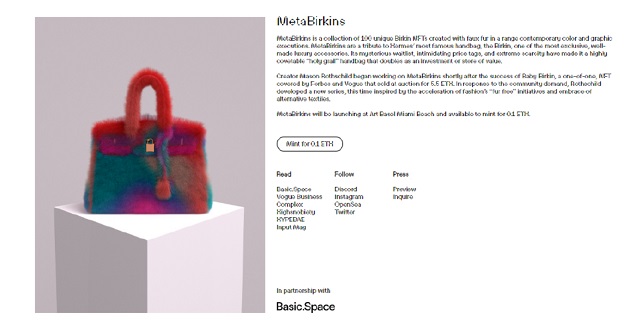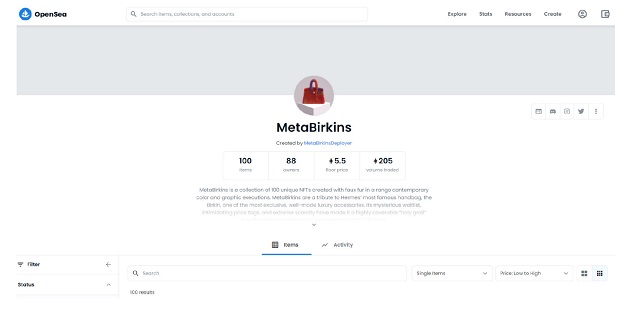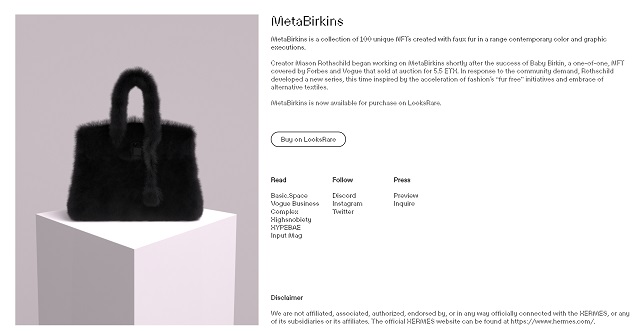NFTs, Trademarks, And The First Amendment: A Primer On Hermès International v. Rothschild – Trademark
Today, a New York City jury will hear opening arguments in the
Hermès International v. Rothschild trial, the
conclusion of which could have precedential implications on what
has become the fine line artists toe between artistic expression
protected by the First Amendment and trademark rights enforced
under the Lanham Act.
Specifically, a jury will be tasked with deciding whether NFTs
representing “MetaBirkins,” created by defendant Mason
Rothschild, are considered artistic expression protected under the
First Amendment, or if Rothschild’s use of Hermès’
BIRKIN and HERMÈS trademarks and trade dress crossed the
line into infringement under the Lanham Act.
Here’s what you need to know about the background of the
case:
What Exactly Is an NFT?
An non-fungible token (NFT) is a cryptographic token
representing a unique unit of data stored on a digital ledger
called a blockchain. In the context of digital art collectables,
the NFT functions as the digital receipt of the purchase of an
associated item, i.e., the digital art. For digital art
NFTs, the art itself is not typically stored within the NFT’s
underlying code, but rather may consist of a .jpeg or other digital
file stored elsewhere online (including on a distributed file
system and peer-to-peer network such as the InterPlanetary File
System, or on a decentralized blockchain data-storage protocol such
as Arweave). The NFT’s code typically points to that
separately stored asset, via a Uniform Resource Identifier (URI),
and the NFT itself may contain other metadata referencing the art
asset or other aspects of the NFT project, such as naming
conventions applied to, or other sorting indices for visual
attributes of, the assets.
Rothschild’s Creation and Sale of MetaBirkins NFTs
In or around December 2021, Rothschild created
“MetaBirkins,” a collection of digital images depicting
faux-fur-covered Birkin handbags. Rothschild then used NFTs to sell
the MetaBirkins. The NFTs have sold on four different NFT
platforms, and though the value of cryptocurrency continues to
fluctuate, some of the NFTs in this collection have been sold for
prices comparable to real-world, physical Birkin handbags.
There is no dispute that Rothschild is using Hermès’
trademarks. The BIRKIN trademark is used as the name of the NFT
token itself, in the source code used to create the NFT, in the
slogan “NOT YOUR MOTHER’S BIRKIN” used to promote the
digital art, in the domain name of the official MetaBirkins website
(metabirkins.com), and on social media. In addition,
Rothschild’s original description of the project on the
MetaBirkins website and in the OpenSea marketplace (in each case,
as documented in Hermès’ complaint) openly admitted that
MetaBirkins were a “tribute to Hermes’ most famous
handbag.”

(Original Description on MetaBirkins Website, subsequently
deleted. Source: Complaint, Figure 5, Civil Action No.
22-CV-00384)

(Original Description of MetaBirkins on OpenSea,
subsequently deleted. Source: Complaint, Figure 10, Civil Action
No. 22-CV-00384)
Rothschild claims his use is a creative expression, asserting
that MetaBirkins are an artistic commentary on fashion’s
fur-free movement as well as on consumerism generally within the
digital space. The MetaBirkins website now features a disclaimer,
noting that the project is “not affiliated, associated,
authorized, endorsed by, or in any way officially connected with
the [sic] HERMES, or any of its subsidiaries or its
affiliates,” with a link to Hermès’ official
website.

(Source: www.metabirkins.com)
Hermès Files Suit Against Rothschild
On January 14, 2022, Hermès filed a complaint,
subsequently amended, against Rothschild alleging, inter
alia, trademark infringement and trademark dilution for the
use of the BIRKIN and HERMÈS trademarks to identify,
promote, and profit from the sale of the NFTs. Rothschild claims he
is entitled to protection under the First Amendment as set forth in
the seminal case Rogers v. Grimaldi, 875 F.2d 994 (2d Cir.
1989) (argued and won by Pryor Cashman). The Rogers case
created a test to determine when the use of a trademark is immune
from an infringement claim because it is artistic expression
protected under the First Amendment. In response, Hermès
argues that even if the MetaBirkins pass the Rogers test,
Rothschild’s use of Hermès’ trademarks was, and is,
explicitly misleading to consumers, as explained in the Ninth
Circuit’s Gordon v. Drape Creative, Inc., 909 F.3d 257
(9th Cir. 2018).
Explicitly misleading use in the context of NFTs was recently
before the U.S. District Court for the Central District of
California in Yuga Labs, Inc. v. Ripps, Case No. CV
22-4355-JFW(JEMx), 2022 WL 18024480 (C.D. Cal. Jan. 16, 2022),
awaiting decision on appeal to the Ninth Circuit. This case
involves one of the most popular and profitable NFT collections,
the “Bored Ape Yacht Club,” created by plaintiff Yuga
Labs. In the spring of 2022, defendant Ryder Ripps, a visual and
conceptual artist, is alleged to have created (together with one or
more co-defendants) a separate NFT project, consisting of tokens
that include URIs pointing to the exact same digital images as used
by Yuga Labs, at their original online storage locations. Yuga has
alleged that, to market and advertise this “mirror” NFT
project, defendants have used Yuga’s marks (including the
acronym “BAYC” and certain logos), including in the same
NFT marketplaces where Yuga’s own collection is sold.
This past December, the district court found that a
“collection of NFTs that point to the same online digital
images as the BAYC collection” did not, in and of itself,
constitute an “expressive artistic work,” and that the
use of Yuga’s marks in connection with this collection was
explicitly misleading to consumers. Ripps, 2022 WL
18024480 at *5. Even more, the court held that Ripps’ website
disclaimer that it had no affiliation with Yuga Labs demonstrated
Ripps’ awareness that its use of Yuga Labs’ marks was
misleading. Id.
The facts of the MetaBirkins case may be distinguishable from
the Ripps project in important ways – including as a result
of Rothschild’s creation of distinct visual assets. Ratcheting
up the stakes, the MetaBirkins and Ripps cases are
proceeding in two different circuits, both considered key in the
development of legal precedent applicable to intellectual property
in creative industries, but neither bound to follow the precedent
established by the other.
Why Is This Dispute Different From Any Other Trademark
Infringement Case, and What Could the Decision Mean for Brands and
Artists?
This is not a standard trademark infringement case, but rather a
case of first impression because of the medium in which the marks
are used. The jury’s decision in this case should help define,
in the context of NFT projects, the blurry line between protectable
artistic expression and commercial products capable of creating
consumer confusion.
Yet the questions underlying that analysis are complex: Is the
expressive artistic statement of an NFT project that involves the
use of an established mark defensible under the Rogers
test, and if so, under what circumstances? Is a distinction
appropriately made between the NFT itself, and the associated
visual artwork – such that one may be found to be protected
speech, but the other to be infringing? Even where an artwork
associated with an NFT, or an NFT project as a whole, is deemed
artistic expression under the Rogers test, are there
circumstances where that test does not apply? These questions will
not be easy to parse in the MetaBirkins case, which is necessarily
fact-specific and thus may not produce sweeping guidance.
The MetaBirkins decision has the potential to provide important
guidance as to what constitutes trademark infringement versus
constitutionally protectable artistic speech in the context of
NFTs. If the jury finds that Rothschild’s MetaBirkins images
and the associated NFTs are protectable artistic expression,
trademark owners may have a more difficult time enforcing their
intellectual property rights against creators and sellers in the
digital NFT marketplace. By contrast, should the jury find that
Rothschild improperly misled the public and used Hermès’
marks for commercial gain, the scope of artists’ freedom of
expression in the context of NFTs will be more narrowly
circumscribed, creating greater risk that certain artworks sold
with NFTs may cross the line into trademark infringement
territory.
The content of this article is intended to provide a general
guide to the subject matter. Specialist advice should be sought
about your specific circumstances.